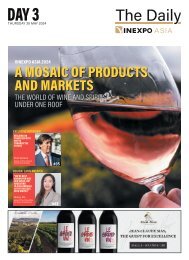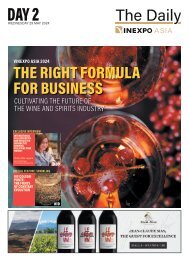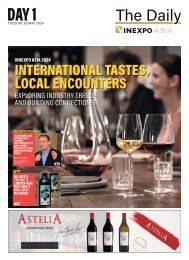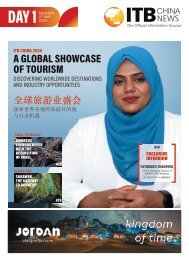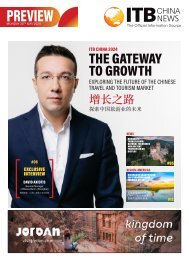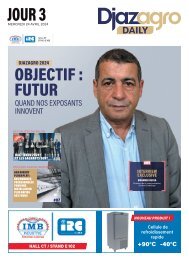You also want an ePaper? Increase the reach of your titles
YUMPU automatically turns print PDFs into web optimized ePapers that Google loves.
SMARTGUIDE
Sarawak: a new vision
Culture, adventure, nature, food and festivals…
in Malaysia’s largest state
INFORMATION
AND IDEAS
FOR TRAVEL
PROFESSIONALS
NEW TOURISM
STRATEGY
HOW SARAWAK
PLANS TO INCREASE
INTERNATIONAL TOURISM
LATEST NEWS:
INFRASTRUCTURE,
ORIGINAL PROMOTIONS,
NOVEL DESTINATION
IDEAS
CONTENT
EDITORIAL
#03 VISION
Reinvigorating tourism in Sarawak
Puan Sharzede Datu Hj Salleh Askor,
CEO, Sarawak Tourism Board
#04 FACTS & FIGURES
Sarawak works to boost international tourism
#05 EXCLUSIVE INTERVIEW
Tourism - an essential pillar of Sarawak’s economy
Datuk Abdul Karim Rahman Hamzah, Minister
of Tourism, Arts and Culture cum Minister of
Youth and Sport, Sarawak
#06 TRADE TALK
Destination Sarawak – as seen by travel
professionals
Richard Barnes
Editor-in-Chief
Sarawak – an open
book for tourism
#07 THEMATIC TRAVEL
UP CLOSE AND
PERSONAL WITH
SARAWAKʼS
DIVERSE
CULTURAL ROOTS
SARAWAK
HOME TO
COUNTLESS
FESTIVALS
#20 MICE
MICE in Sarawak
#08
#21 TRANSPORT & INFRASTRUCTURE
#23 SARAWAK MAPS
#12
WHITE RAJAH
BROUGHT BACK
TO LIFE
#10
NEW ROLE
FOR
SEMENGGOH
#18
Destination Borneo, and more
particularly the Malaysian state
of Sarawak, evokes a number
of images for people today: a
wild land… the domain of the
orangutan… the numerous Dayak
indigenous cultures… virgin
rainforest… the extraordinary
history of Sarawak’s “White
Rajahs”. Indeed, Sarawak today
still has all of that, but also
boasts a tourism offering that
is evolving quickly, while seeing
the application of a strict policy
ensuring eco-responsibility and
sustainability.
One cannot say Sarawak has
everything. No, it doesn’t
have skyscrapers, it doesn’t
have multi-lane traffic jams, it
doesn’t have thick smog haze,
and it certainly doesn’t have
overtourism. Sarawak remains
very much an open book when
it comes to tourism, in a good
sense, as the state authorities
have been able to look at best
and worst-case scenarios in
other parts of Southeast Asia,
and plan accordingly to ensure
tourism in this state heads in the
right direction.
With a new CEO since late 2018, in
the person of Sharzede Datu HJ
Salleh Askor, Sarawak Tourism
Board is honing strategies for
promotion and infrastructure
improvement with a view to
developing international tourism.
This is being done in such a way
as to benefit local communities,
while delivering unforgettable
experiences – truly adding value
– through a new multi-pronged
plan covering culture, adventure,
nature, food and festivals
(CANFF).
This SMARTguide aims to be
a veritable “decision-making
tool” for the travel professional,
delivering important destination
news and new ideas when it
comes to planning travel to this
place. We are sure you will find
it to be extremely valuable for
all those in the travel planning
business.
Edition, produced by CLEVERDIS, 65 avenue Jules Cantini, Tour Méditerranée, 13006 Marseille, France - Tel: + 33 442 77 46 00 - info@cleverdis.com • www.cleverdis.com
SARL capitalised at Euros 155,750 - RCS Marseille 413 604 471 - VAT FR 95413604471
President & CEO: Gérard Lefebvre - Managing Director: Jean-François Pieri - Production Manager: Jean-Guy Bienfait - Editor-in-Chief: Richard Barnes -
Head of editorial team: John Falchetto - Art Director: Hélène Beunat.
With the participation of: Bettina Badon, Benjamin Klene, Xiaojing Si, Jasdeep Singh, Veronika Verzhak
• On cover: Iban longhouse on Batang ai lake © Cleverdis
• Registration of Copyright March 2020. Information presented in this publication is purely indicative in order to illustrate subjects contained therein. No guarantee can be given as to the accuracy of data or content at time of printing and thus
the latter should not be used to professional or commercial ends. While all efforts have been made as to accuracy and pertinence of content and data contained in this publication, CLEVERDIS may in no case be held responsible for the consequences,
whatever their nature may be, that may result from the interpretation of this data or content, or any eventual errors therein. All rights are reserved. Any reproduction of the content of this publication, even partial, by any procedure whatsoever, is strictly
prohibited without the prior authorisation of the publisher. Any copy, whether by photography, photography film, magnetic tape, disc or other means constitutes a forgery, liable to punishment under French law under the legislation of 11 th March 1957
covering copyright. All brands cited in this publication are registered trade marks and/or belong to companies which are their respective proprietors. The publishers and editorial staff decline all responsibilty as to opinions formulated in this publication
by those interviewed or cited therein. Their opinions are entirely their own, and are included with the understanding that they contain, to our knowledge, no malicious intent. The inclusion of all texts, photographs and other documents supplied by those
included in the report imply the acceptance by their authors of their free publication therein. Documents and photgraphs are not returned. It should be understood that this publication contains forward-looking statements that involve risks,
uncertainties and assumptions. All statements other than statements of historical fact are statements that could be deemed forward-looking statements. Risks, uncertainties and assumptions include assumptions relating to the timing of the record
date. If any of these risks or uncertainties materialises or any of these assumptions proves incorrect, actual results could differ materially from the expectations outlined in these statements. Cleverdis assumes no obligation and does not intend to
update these forward-looking statements during the period of publication. Photo Credits and Copyright: All Rights Reserved
2 SMART GUIDE www.sarawaktourism.com
Datuk Abdul Karim
Rahman Hamzah
Minister of Tourism, Arts, Culture,
Youth and Sports, Sarawak
WE ARE SATISFIED
WITH THE POSITIVE
GROWTH OF VISITORS
TO SARAWAK LAST YEAR,
RECEIVING 231,498
MORE VISITOR
ARRIVALS COMPARED
TO 2018
Vision
Reinvigorating
tourism in Sarawak
Puan Sharzede Datu
Hj Salleh Askor
CEO – Sarawak Tourism Board
2020 is an encouraging year
for Sarawak Tourism Board
as we wet the Visit Sarawak
Campaign Phase Two into
action. We are satisfied with
the positive growth of visitors
to Sarawak last year, receiving
231,498 more visitor arrivals
compared to 2018 (2018:
4,430,921 & 2019: 4,662,419)
- a growth rate of +5.22%.
As part of this, we achieved
a significant rise in visitor
arrivals from the domestic
market, with a growth rate of
+11.3%. The Sarawak Tourism
Board is working on improving
our existing strategies and
plans. Having set the target
of five million visitor arrivals to
Sarawak, we are confident that
with the intensive marketing
and promotional campaigns
of Sarawak Tourism Board in
domestic markets and the
ASEAN region, this should be
achievable. We are working
on building collaboration with
airlines, enhancing our digital
platforms, and continuing
aggressive promotion and
marketing campaigns in all
our focus markets.
We are also seeking to grow the
long-haul market in addition
to the ASEAN market and
“border” tourism. As we know,
visitors from Europe, the USA,
and more locally, Australasia,
love our adventure offering,
our nature and culture, trying
the exotic food and having fun
at our festivals. One of the key
ways we’re developing the
long-haul market is through
a strong presence at major
trade shows around the world,
as well as through online and
print advertising.
Key issues and challenges
for us moving forward
are primarily based on
connectivity. We are working
hard to bring together
all industry players, from
Government, private and
public sectors. Moving into
this new decade, Sarawak
will, I am sure, see a major
transformation in terms of
air connectivity, and to this
end, we aim to encourage
more direct flight to Sarawak,
especially to the central
regions Sibu, Bintulu and
northern region, Miri. The
development of Sarawak’s
road networks will also be
an essential factor in the
development of tourism.
Digital marketing is also
becoming increasingly
important. We are
collaborating with industry
players to get more
involvement in digital
marketing, need to identify
the local operators, industry
players that are willing to
increase Digital marketing,
hence, moving to digital
footprint. Moreover the
Sarawak Government also has
a budget for digital marketing.
Our main pillars of Sarawak
as a tourist destination?
“CANFF”: Culture, Adventure,
Nature, Food and Festival
are the main pillars. All these
things combined make
Sarawak a destination that
is highly unique and can,
in themselves, help travel
professionals create an
unforgettable itinerary for
their clients
www.sarawaktourism.com
SMART GUIDE 3
FACTS & FIGURES
© 2019 Rob Allyn / STB
Outdoor activities
are a big driver for
tourism in Sarawak
Facts & figures
Sarawak works to boost international tourism
2020 sees Sarawak heavily promoting its
destinations to overseas source markets as
part of the ongoing Visit Sarawak campaign,
coupled with Visit Malaysia 2020.
The past year has seen 5.2%
growth in inbound travellers
to Sarawak, from 2018 to
2019, with an overall total
of 4,662,419 visitors in the
year. Around 2 m of these
are foreigners. To get a better
grasp of Sarawak’s inbound
figures, it is important to
note that a large part of
the international figures
quoted concern visitors from
neighbouring countries –
Brunei (1,296,017 visitors in
2019), Indonesia (418,461 in
2019), and the Philippines
(63,238 in 2019). A number
of these visits may thus
have been visits to family
and friends, or occasional
business visits, rather than for
leisure tourism. Unlike many
other countries, Sarawak’s
tourism infrastructure has
gone from almost zero in the
1970s, to what it is today. In
1972, total tourist numbers
for the entire state were
54,223.
An interesting market for
Sarawak today is Singapore
(traditionally a major source
market for all of Malaysia).
From 2018-19, the number
of visitors from Singapore
jumped by 7% from 43,734
to 46,812. Australia, another
major source market for
Sarawak, saw growth of 3.9%
in visitor numbers in the year
to 2019, with a total of 16,881
inbound travellers.
Over the past year, visitor
numbers from key source
markets in Europe, such as
the UK, France and Germany
remained relatively static,
with a drop of around 4% in
German visitors balanced
out by a similar increase in
visitors from France, while UK
visitors, which by far make
FROM
2010 TO 2019,
OVERALL
INBOUND
TOURIST
ARRIVALS
GREW BY 42%
up the lion’s share of the
European market, remained
stable at 32,194 in 2019.
As figures tend to vary country
by country from one year to
another, it is interesting to
look at broader trends over
the past (almost) decade.
From 2010 to 2019, overall
inbound tourist arrivals grew
by 42%, primarily buoyed
by a growth in domestic
travellers visiting the state.
Over that time, there has
also been remarkable growth
in Indian visitors – from
16,533 to 26,791 – a rise of
62%. Singaporean visitor
numbers were up by 21%,
Germans +11.45% and most
interestingly, the biggest
growth for a European
country came from France
with a rise of 64% over the
nine years, from 3,856 in
2010 to 6,325 in 2019. For
its part, South Korea saw the
biggest growth over the nine
years from 2010 to last year,
up by 103% from 5,327 in
2010 to 10,820 in 2019. Major
growth has also come from
Taiwan, up 47.7% to 10,004
visitors from 2010 to 2019
4 SMART GUIDE www.sarawaktourism.com
EXCLUSIVE INTERVIEW
Datuk Abdul Karim
Rahman Hamzah
Minister of Tourism, Arts and Culture
cum Minister of Youth and Sport,
Sarawak
WE ARE
BUILDING
CONNECTIVITY
AND
ACCESSIBILITY
FOR WHAT
REMAINS FOR
MANY A TRULY
MYSTICAL
DESTINATION
Tourism - an essential pillar
of Sarawak’s economy
Exclusive interview: Datuk Abdul Karim Rahman Hamzah, Minister of
Tourism, Arts and Culture cum Minister of Youth and Sport, Sarawak
According to the “regional satellite account”
of Sarawak 2018, tourism generated RM11bn
(€2.43bn) – 7.5% of Sarawak’s gross domestic
product. We asked Minister of Tourism, Arts,
Culture, Youth and Sports Datuk Abdul Karim
Rahman Hamzah to tell us more.
In 2018, 240,000 people were
employed in Sarawak thanks
to the tourism industry: 19.1%
of Sarawak’s workforce.
Our focus is on culture,
adventure, nature, food &
festivals (CANFF). This also
means tourist attractions are
not only focused on urban
areas but are extended to
villages and rural areas. In
terms of road connectivity,
two projects will be completed
this year, in the areas of
Sibu and Kapit, opening up
new areas along the Rejang
River, where tourists will be
able to explore the exquisite
nature of these untouched
rural areas. Then there is
the Bintulu – Sungai Asap –
Belaga link. Sungai Asap is a
new settlement and Belaga is
a big town in the area.
How is tourism infrastructure
evolving?
Sarawak’s State government
supports the upgrading of
infrastructure such as the
Pan Borneo Highway, Coastal
Highway, museums and
sports arenas. We are also
dedicated to the upgrading
and development of the
internet in Sarawak to improve
connectivity for tourists,
developing the Sarawak Travel
Application. We are continuing
to build connectivity by
seeking to attract new airlines
and routes into Sarawak’s key
airports.
An unprecedented number
of new tourism projects are
opening in the coming months
and years. The 2 nd largest
Museum in Southeast Asia
will open in Kuching at the end
of 2020. Then there are the
Sarawak Culture Museums,
also in 2020; the Performing
Arts Centre – to be completed
within 2 years; the Santubong
Archaeological and Wildlife
Centre, the Beautification
of Pangkalan Sapi, the
upgrading of waterfront
facilities; construction of a
riverside walkway from Fort
Margherita to the Darul-
Hana Bridge; development of
museums in Limbang; Tusan
beach facilities; Sadong-
Jaya mangrove tourism – a
sanctuary for birds to migrate
from Indo-China, with the
gazetting of the area as a
National Park; at the Niah
Cave, there is extensive
upgrading of the walkway from
the river to the cave, along
with the addition of bungee
track and trails; and finally
upgrading of Bako National
Park and Semenggoh Nature
Reserve’s facilities.
What if your “message” to
travel professionals from
around the world?
Our tourism products are
very exotic for visitors from
Europe and also the Middle
East, because most have
never seen “nature in the raw”
such as what can be found
in Sarawak. We are building
connectivity and accessibility
for what remains for many a
truly mystical destination,
with the focus on our “big five”
- culture, adventure, nature,
food & festivals
www.sarawaktourism.com
SMART GUIDE 5
TRADE TALK
Destination Sarawak
– as seen by travel professionals
Michael Metzner
CEO Tischler Reisen AG,
Germany
Gary Speldewinde
Director – Ecogreen Holidays,
Kuching, Sarawak
Philip Yong
Co-founder and Managing Director,
Borneo Adventure
OUTBOUND TO
SOUTHEAST ASIA
INBOUND TO SARAWAK
We are recognising a growing
trend towards individual quality
tours. Sustainability is becoming more
and more important. Also, tours
combining several different countries
or destinations are popular. An example
might be Singapore combined with a
nature and wildlife experience in
Sarawak/Borneo.
As a specialist for individual tailor-made
quality tours to Asia, Oriental countries
and Indian Ocean we are always
looking for untouched destinations off
the beaten track. Sarawak is truly one
of these natural gems and fits perfectly
in our portfolio. Private tours to the
National Parks including trekking tours
in the rainforest, wildlife observation
and experience of the great variety of
culture are just some of the highlights,
Sarawak has a lot to offer, and an
increasing number of our clients are
attracted to exploring the destination
every year.
Ecotourism is a major trend
today. People want to find
out more about the country, the
culture, the cuisine, and the
indigenous people; but to do this,
you need somebody in the field who
knows the ropes. We prefer to
organise tours where people
actually live in a village and stay with
the local inhabitants.
… We have just signed with a new
online portal in Europe: a site
launched at the end of February
2020. They focus on ethnic tribes
of different countries. With them,
we are developing tours of up to 12
days, learning about the lifestyle
of the local communities. There is
so much to learn that it would be
impossible to do so in one’s entire
lifetime, but with a tour like this,
people can really see a lot!
Sarawak exceeds expectations.
On the surface, we could
advertise about culture, nature and
adventure, but there is a whole lot
more than that. There’s food, there are
festivals, there is an incredible variety,
and the layering of so many things,
and that is a bonus. I think we do have
some stunning places. Kuching still
has a bit of an old city laid-back charm;
Mulu is spectacular… it always takes
my breath away.
There are a variety of things people
can do. For example, we can take
people to see Orangutans in the wild.
Not many people have done that. You
can see them in the zoo. But there
are probably less than ten thousand
people who have seen Orangutans in
their natural habitat in Sarawak. There
is something for everyone – families,
adventure travellers or couples.
6 SMART GUIDE www.sarawaktourism.com
CULTURE
Southeast Asia’s new
cultural highpoint
Malaysia’s biggest, most spectacular new
museum set to open in Kuching in 2020
It’s set to become the “shining star” of Malaysia’s, and indeed the
entire region’s cultural scene. Sarawak’s new state museum in
Kuching – Malaysia’s biggest, the second biggest in Southeast
Asia – will open to the public later this year.
The new museum and annexe are part
of the Sarawak Museum campus, which
also includes the old Sarawak Museum,
the Natural History Museum, and the Art
Museum.
The new 30,000 sq m building will ensure
that the Sarawak heritage, in the form of
a wide array of collections, is safely and
securely stored, preserved, documented,
researched and well exhibited,
according to the latest standards by the
International Council of Museums.
The new five-storey building will have
exhibition spaces on Levels 2 through 5,
on two wings flanking a central atrium.
Level 1 will house commercial lots, a café,
function rooms and auditorium spaces,
supporting and complementing the
exhibition gallery.
The main building is connected to a threestorey
annexe, housing the museum’s
offices, conservation and research
spaces, library and archives, while the
entire basement level is a dedicated
storage area.
The property has been under construction
since 2014, at a cost of around €70 m. It
is Malaysia’s first museum to be Green
Building Index (GBI) certified. Ecofriendly
building materials include timber
products certified by the Programme for
the Endorsement of Forest Certification
(PEFC) for the floors and interior wall
panels. Following the demolition of the
Dewan Tun Abdul Razak building to make
way for the new museum, conscious
efforts were also made to retain the
large trees on site and to preserve the
surrounding context as much as possible.
While the building was completed last
August, with an official hand-over
ceremony attended by Minister of
Tourism, Arts, Culture, Youth and Sports
Datuk Abdul Karim Rahman Hamzah,
opening time is slated for later this year.
When complete, visitors will embark upon
an interactive journey through Sarawak’s
history, and the lifestyles of the state’s
numerous ethnic communities.
The Sarawak Museum had long been
hailed as one of the best in this part of
the world, with its old wing dating back
to 1891. The new building will serve as a
centre of learning, hosting international
scholars to collaborate with local
curators on documenting the material
knowledge of Borneo’s rich past, along
with its cultures, people and nature.
It aims to establish Sarawak as a new
global focal point for work in the field of
anthropology
www.sarawaktourism.com
SMART GUIDE 7
CULTURE
© 2019 Rob Allyn / STB
Jonathan Rhys
Meyers in the
upcoming
White Rajah
White Rajah brought
back to life
The legendary “founding father” of Sarawak set
to hit the big screen in new Hollywood extravaganza
For many in the western world, the name
Sir James Brooke has little meaning. That’s
about to change, as a new Hollywood
blockbuster, filmed at the end of 2019, and
in post-production in early 2020, will soon
be hitting the world’s screens.
The movie, with the working
title “White Rajah”, tells the
story of how this former
British soldier, who sailed
to Borneo in 1839 in search
of adventure and fortune,
came to be known as the
White Rajah of Sarawak,
after helping the Sultan
of Brunei crush a pirate
rebellion.
The new film was produced
by Rob Allyn, directed
by Michael Haussman
and stars Jonathan Rhys
Meyers in the role of the
Rajah. Rhys Meyers is best
known for his roles in Match
Point, Mission: Impossible
III, and Tudors and Vikings.
Actor Dominic Monaghan,
who played the hobbit
Merry in the Lord of the
Rings trilogy, takes the
role of Colonel Arthur
Crookshank, Brooke’s
cousin and comrade-inarms.
The production was made
in cooperation with the
Brooke Heritage Trust,
supported with Malaysia’s
federal FIMI film rebate -
the first time the rebate has
been used to make a major
movie outside of Peninsular
Malaysia. Sarawak’s
Minister of Tourism, Arts,
Culture, Youth and Sports,
Datuk Abdul Karim Rahman
Hamzah, has placed his
support behind the project,
saying he felt that the
fact the film showcases
many beautiful locations
in the state will arouse
great interest in travel to
Sarawak.
Shooting took place in the
rustic town of Siniawan,
the Fairy and Wind Caves in
Bau, Sarawak, the Sarawak
Cultural Village and Borneo
744.
Producer Rob Allyn says
he hopes his new film will
be ready in time to screen
at the 2020 Cannes Film
Festival in May
WHITE
RAJAH EPIC
ORIGINALLY
PLANNED
BY ERROL
FLYNN IN
1936
The successful filming of
this Hollywood epic comes
around 84 years after a first –
unsuccessful – bid to make a
film about the White Rajah, by
none other than Errol Flynn,
who was also to star in the film.
The film never came to fruition,
due to legal wrangling between
the would-be producers,
Warner Brothers, and Lady
Sylvia Brooke, the then Ranee
(Queen) of Sarawak over
“historical accuracy”.
8 SMART GUIDE www.sarawaktourism.com
CULTURE
The Antithesis
of British colonial rule
Sarawak Raj was a very “different” kind of
leadership
Sir James
Brooke
The White Rajahs ruled Sarawak from
1841 to 1946. The first ruler, subject of the
new Hollywood feature film, was Sir James
Brooke. As a reward for helping the Sultan
of Brunei fight piracy and insurgency
among the indigenous peoples, he was
granted the province of Sarawak in 1841,
as an independent Kingdom.
DELVING INTO HISTORY
AT FORT MARGHERITA
In Kuching, the very
prominent Fort Margherita
on the riverfront was built
by the second Rajah,
Charles Brooke. Designed
in the style of an English
castle in 1879, it protected
Kuching from pirate
attacks, and was named
after Charles Brookes’ wife
Margaret Alice Lili de Windt.
In 2016, having previously
housed the Police Museum,
it was transformed into
the “Brooke Gallery” –
showcasing the Brooke
dynasty
Brooke pursued a policy
of paternalism, with
the goal of protecting
the indigenous peoples
– the Iban and other
Dayak tribes – from
capitalist exploitation.
He installed laws banning
slavery, headhunting and
piracy.
After James Brooke laid
much of the groundwork
for the expansion of
Sarawak, his nephew
Charles, the second
Rajah, was the “great
builder”. He constructed
public buildings, such as
a hospital, in addition to
forts, as well as extending
the borders of the state.
Vyner Brooke, the son
of Charles, instituted
significant political
reforms. He ended
the absolute rule of
the Rajah in 1941,
before the Japanese
invasion during World War
II, by granting new powers
to the parliament.
The Brooke family still
maintains strong ties to
the state and its people
and are represented
by the Brooke Trust, and
by Anthony Brooke’s
grandson Jason Desmond
Anthony Brooke, at
many state functions
and supporting heritage
projects.
The Brookes’ architectural
legacy can still be seen
throughout Sarawak
Fort Margherita (centre),
with the State Assembly (right)
ANOTHER REMINDER
OF THE BROOKE LEGACY:
FORT ALICE, SRI AMAN
Fort Alice, built in 1864
in the coastal town of Sri
Aman, around 200km
north of Kuching, was given
the second name of the
Rajah’s wife. After years of
loving restoration, it
was opened to the
public in 2015, and
won the gold award
for conservation in
Malaysia’s Institute
of Architects’ 2017
Awards. The gallery
inside shows the
history of the fort itself, the
small town of Sri Aman as
well as the tense contention
between the Iban people
and the British soldiers of
the Brooke era
Fort Alice,
Sri Aman
www.sarawaktourism.com
SMART GUIDE 9
CULTURE
The real thing:
an Iban longhouse
at Batang Ai
Up close and
personal with
Sarawak’s
diverse
cultural roots
The Sarawak Cultural
Village, a stone’s throw from
Kuching, is so authentic
that it was used as a set for
the upcoming Hollywood
blockbuster, the White
Rajah. The village is a living
museum: ideal for a halfday
visit. The diversity of
Sarawak’s tribes is simply
extraordinary.
“If you take the example
of the Orang Ulu, they are
divided into 26 different
sub-groups, each of which
doesn’t speak a different
dialect, but speaks a
whole different language”,
explains Gary Speldewinde
– Director – Ecogreen
Holidays, Kuching, Sarawak.
The Cultural Village’s
buildings represent every
Penan
blowpipe
demonstration
at the Sarawak
Cultural Village
major ethnic group in
Sarawak; namely the
Bidayuh, Iban, Orang Ulu,
Penan, Melanau, Malay &
Chinese. Upon entering
each building, after
witnessing a traditional
welcome ceremony, visitors
find members of the
ethnic groups in traditional
costume carrying out
traditional activities and
taking time to pose for a
photo or two. At the Penan
hut, visitors also have the
opportunity to witness the
art of blowpipe making.
They can also try their hand
at blowpipe shooting with
the Penans, the last of the
hunters and gatherers –
forest nomads
While the Sarawak cultural
village is exceptional,
nothing beats the real
thing. A few hours’ drive
outside Kuching, one
arrives at Batang Ai dam
– the shores of which are
home to a number of Iban
people living in traditional
longhouses, leading simple
lives.
The biggest community –
the Mengkak longhouse
– has 38 families, totalling
around 200 people. The
community is around 45
minutes’ boat ride from the
nearest resort or road.
Visiting this place, one
instantly understands that
these people are, on the
one hand, quite reserved,
and on the other, are very
hospitable. Their traditional
rituals, dances, foods,
and costumes continue
to intrigue and fascinate
visitors and researchers
from around the world.
The longhouse is made
up of a large communal
living space, called the
ruai, flanked on the outside
by a terrace, and on the
other by individual rooms
– each housing a family.
The ruai is the place
where the longhouse folk
gather for a chat or carry
out their days’ activities.
Here, one eats with the
Iban, seated on the floor,
savouring local fare, after
tasting the home-made
rice wine and (gulp) rice
‘whisky’.
These are the direct
descendants of the Iban
head-hunters, whose
images from yesteryear
fuelled the curiosity of so
many in the past. Apart
from the head-hunting,
little else has changed.
It is truly an immersive
experience
A traditional dance in
the Mengkak longhouse
10 SMART GUIDE www.sarawaktourism.com
I ADVENTURE I NATURE
Penan woman, selling
handicrafts at Batu
Bungan village (Mulu)
Tourism
as a cause
for good
As often stated by the
former Secretary-General
of the UNWTO, Taleb Rifai,
tourism can and should be
a force for good. In Sarawak,
this is very much the case,
as every person who visits
Sarawak’s national parks
and protected areas and
pays fees contributes to
the upkeep of these fragile
forests – much of them
pristine primary growth –
and protects the unique
wildlife that lives within
them.
Some local tour operators
also offer the chance for
visitors to become involved in
reforestation initiatives. Park
buffer zones are extremely
important in increasing the
available habitat for wildlife,
so by extending the forest
cover this further helps
in protecting the wildlife.
Huge steps are being made
across the state to conserve
and manage Sarawak’s
valuable and unique
forests. In addition to some
800,000 hectares of Totally
Protected Areas (TPAs)
that are off-limit to logging
companies, large areas of
land classed as “terrain
4” (steep and hilly) areas,
“High Conservation Value
Forests”, buffer zones and
verified “Native Customary
Rights” land remain pristine.
The declared initiative by
the state government to
pursue responsible tourism
underpins the importance
of other moves that had
already been initiated by the
state authorities to protect
forests and wildlife
Upgraded
infrastructure for
Bako National Park
With foreign tourist numbers to
Bako National Park growing by
an average of around 15% every
year for the past three years, the
Sarawak Forestry Corporation
has been working on adding
to and refurbishing facilities for
visitors, including the opening
of a new camping ground. The
Bako Boat Terminal was also
temporary closed for renovation
and upgrade by the Sarawak River
Board from 15 April 2019 through
February 2020.
Bako is said by many to be
the best place in Sarawak for
wildlife experiences. It is home
to approximately 150 rare
proboscis monkeys, found only
in Borneo. The park has been
a protected area since 1957, so
animals are less wary of humans.
Visitors, especially those who
stay overnight, have countless
opportunities to observe and
photograph various types of
wildlife. Long-tailed macaques,
silvered leaf-monkeys, common
water monitors, plantain squirrels,
wild boar and mouse deer are also
found here.
The largest mammal found at
Bako is the Bornean Bearded
Pig. As its name implies, it is
distinguished from other wild
pigs by prominent bristles either
side of its snout. Bearded pigs are
often found around the park HQ
scavenging for food or wallowing
in mud
Proboscis
Monkey in
Bako National
Park
www.sarawaktourism.com
SMART GUIDE 11
ADVENTURE I NATURE I
Orang-utan in
Semenggoh park
New role for Semenggoh
Until recently known as an orangutan “rescue centre”
the status has now changed to “nature reserve”
For over 20 years, the wardens at Semenggoh Nature Reserve
had been training young orangutans, orphaned or rescued
from captivity, on how to survive in the wild. The success of
this programme has left the surrounding forest reserve with
a thriving population of healthy adolescent and young adult
orangutans, who are now breeding in the wild.
The rescue programme has thus been
transferred to Matang Wildlife Centre,
leaving Semenggoh Nature Reserve as
a comfortable home to its successful
graduates, semi-wild orangutans and
their babies.
These majestic animals – our closest
“cousins” in terms of DNA, once kept
illegally as pets, are trained on how
to fend for themselves before being
released into the forest. Over the years, a
number of orangutans have been trained
and released and now form a semi-wild
colony in the reserve. As regular as
clockwork, they swing down from the
trees for a free handout of fruit. If it is
the fruiting season in the forest, some or
even all of them may not come to feed.
This in itself is a good sign and another
step on the way to full rehabilitation.
MATANG TAKES OVER
AS MAIN RESCUE CENTRE
Matang Wildlife Centre is to be found at
the western corner of the Kubah National
Park, about 40 minutes’ drive from
Kuching. The centre’s 180 hectares
of lowland forest provides natural
surroundings for orangutans and other
local fauna. Matang is a dedicated
centre where endangered species, such
as orangutans, are rehabilitated and
released into the forest. While they are
being educated, they remain at the centre,
enabling visitors to get close to animals
they might not spot in days of wandering
the jungle. (Please note that wildlife
sighting activities in Matang Wildlife
Centre will be temporarily ceased from
1 st January 2020 until 30 th June 2020 (6
months) in order to facilitate repair and
maintenance works on the infrastructure.)
WORK HANDS-ON TO SAVE
ORANGUTANS? YES, YOU
CAN!
Foreign visitors to Sarawak are
able to volunteer to work with an
orangutan conservation programme.
With Orangutan Project Sdn Bhd,
a conservation company offering
alternative solutions and sustainable
funding opportunities for the endangered
wildlife on Borneo, visitors can give
“hands-on” help in their quest to save
the Red Apes of Borneo, with monthly
departures to Batang Ai National Park
12 SMART GUIDE www.sarawaktourism.com
I ADVENTURE I NATURE
© 2019 Paradesa
Cycling
Borneo
Trans-Borneo
Road Bike
KAYAKING
SARAWAK -
PADDLING
IN
PARADISE
For great photo
opportunities (with a
waterproof camera),
kayaking on Sarawak’s
Semadang River is a
must.
Semadang Kayak is the premier
kayaking, bamboo rafting
and adventure outfitter and
service provider operating on
the Sarawak River (Semadang
River) at the Heart of Borneo’s
Rainforest a short drive from
Kuching, Sarawak.
“Trans-Borneo Road Bike” has
been launched by Kuchingbased
adventure tour operator
Paradesa* as a two-week
adventure through the wilds of
this incredible island.
Visitors cycle a total of 1,370 kilometres on
paved roads along the South China
Sea and beaches, through mangrove
forests and plantations, stunning
landscapes and peaceful villages before
taking on some challenging climbs to
truly appreciate the natural splendour
of Borneo. Accommodation varies
from beachside / mountain resorts to
international city hotels, and even a local
homestay.
The itinerary covers two countries,
8 international crossings and 1,370
kilometres in 12 cycling days, with
enthusiasts cycling end-to-end,
travelling East to West from the state
of Sarawak, finishing in style in Sabah,
crossing through the Sultanate of Brunei
along the way.
Highlights include encountering the
hospitality of the multi-ethnic peoples
of Borneo, exploring remote national
parks of Sarawak for wildlife spotting,
and being among the first to boast riding
across Borneo.
Those who like cycling, but perhaps
not to the point of crossing the entire
island, will find an eclectic range of
other possibilities, with a number of
short cycling itineraries, including “Best
of Kuching: Heritage and Kampong
Bike Tour”, “Sunset Kampong Ride with
Hawker Food”, “A bite of Borneo by Bike”,
and “Kuching Bike and Cook”.
*Winner of 7th Sarawak Hornbill Tourism
Award 2015/2016: - Outstanding
Destination Management Company -
Special Recognition: Emerging DMC
Award
With various package choices,
the local operator takes visitors
on the “kayaking and rafting
trip of their life”. The trip is a
family friendly and suitable for
beginners, including a short
“training” session at the start of
the activity. Lunch is included
in a small village along the way.
The organisers themselves take
photos of the intrepid kayakers,
sent to them by email just after
their visit
Semadang
Kayak
www.sarawaktourism.com
SMART GUIDE 13
ADVENTURE I NATURE I
Celebrating 20 years World Heritage status
Mulu underlines legacy from the past, being lived today, set to be
passed-on to future generations
In November 2020, Mulu National Park
celebrates the 20 th anniversary of its being
named one of only 20 World Heritage sites
in the world that qualify for a total of four
key world heritage criteria. Mulu boasts
superlative beauty – mountains, combined
with huge river systems, a tropical
rainforest and huge caves. The earth’s
history and geo features are evident in the
gigantic caves and the Pinnacles. Visitors
appreciate the biodiversity and ecological
processes when adventure trekking or just
strolling along the botany trails.
© 2018 Jorg Sundermann
Melinau river sunset
at Mulu Marriott Resort
Deer Cave, Mulu
National Park
“REVEALED” IN THE 1970’S
The mystery and magic
of Borneo has lured the
cream of the scientific
world since it was first
discovered. In 1978,
the Royal Geographical
Society launched one
of the biggest multidisciplinary
expeditions
to Mulu. Prior to this, the
Sarawak Government,
recognising the special
qualities of Mulu, had
gazetted it a National Park
in 1974. The magic caught
on in 2000, and Mulu
was declared an iconic
UNESCO World Heritage
Area, and at 55,000
hectares, also the state’s
biggest National Park.
Gunung Mulu National
Park is now the most
intensively studied area
of tropical karst in the
world. Dominated by
Gunung Mulu, a 2,377m
sandstone pinnacle
(the second highest
mountain in Sarawak),
the area is exceptionally
scenic, with rainforestcovered
mountains,
wild rivers in deeplyincised
canyons, sheer
limestone pinnacles, long
underground passages
and immense caves.
CAVES: THE WORLD’S BIGGEST
In terms of total volume, Mulu
boasts having the biggest cave
system in the world. At least 295
km of explored caves include
the Sarawak Chamber - the
largest known cave chamber
in the world at 600 m by 415 m
and 80 m high. With a volume
of 12 million cubic meters and
an unsupported roof span of
300 m, this chamber dwarfs
any other large chamber so
far discovered. Deer Cave at
120 to 150 m in diameter is
the largest cave passage in the
world known at the present
time and the Clearwater
Cave System holds the world
record as the longest cave in
Asia at 110 km of mapped and
explored passages. The caves
show classic underground
geomorphological features
which reveal an evolutionary
history of more than 1.5 million
years.
Both above and below ground
the Park has a wide range of
endemic animals and plants in
seventeen vegetation zones.
The caves house millions
of swiftlets and bats and
provide outstanding scientific
opportunities to study the
origins of cave fauna.
14 SMART GUIDE www.sarawaktourism.com
I ADVENTURE I NATURE
MEETING THE LOCALS
– ORANG ULU, THE UPRIVER PEOPLE
From the river-based Berawan tribes of
Long Terawan to the now settling Penan
in the villages of Batu Bungan and Long
Iman: these are the Mulu locals and
they play an integral part in the affairs
of Mulu National Park. These villages
are also made accessible for tourists
to visit, specifically to enjoy the local
handicraft market and of course to try
their hand at the weapon of choice –
the blowpipe! The workforce of the Park
consists of 96% locals and all are proud
Sarawakians.
River at Mulu
GUNUNG MULU
NATIONAL PARK
– PROTECTING
HERITAGE
FOR FUTURE
GENERATIONS
A recent study (2017) by the IUCN
World Heritage Outlook resulted in a
“good” status, with the IUCN stating,
“The combination of the remoteness
(no public road access), rugged
terrain, legislative basis of protection,
existence and implementation of
an Integrated Development and
Management Plan, 5-year plan, very
effective professional management
and dependence of a valuable
tourism industry on the park augurs
well contributing to ongoing effective
protection and management.”
According to the UNESCO World
Heritage Committee, “GMNP
provides outstanding scientific
opportunities to study theories on
the origins of cave faunas. With its
deeply-incised canyons, wild rivers,
rainforest-covered mountains,
spectacular limestone pinnacles,
cave passages and decorations,
Mulu has outstanding scenic values.
GMNP also provides significant
natural habitat for a wide range of
plant and animal diversity both above
and below ground. It is botanicallyrich
in species and high in endemism,
including one of the richest sites in
the world for palm species.”
HIGHLY TRAINED GUIDES
When a guide leads a group into
the Mulu caves he or she is not only
an interpreter, allowing people to
understand the nature, but they also
act like rangers, ensuring the visitors
keep their litter, and do not harm the
environment.
The park itself employs around 20
guides and there are a number of
freelance guides working permanently
with travel agencies, bringing the total
to 60 guides.
CANOPY WALK
At 480 metres in total length and
built in 2007, Mulu has the longest
tree-based walkway in the world.
Here, guides help visitors better
understand the flora and fauna
of the tropical forest.
Mulu canopy
walkway
Jeffrey Simun,
Operation Manager,
and Bian Rumei,
Tourism Services
Manager, Borsamulu –
Mulu National Park
“Guides have to attend a course
which is run by the Sarawak Forestry
Corporation for 21 days, and Borsamulu
runs a course which lasts around 10
days, very specific on the park product,”
explains Jeffrey Simun, Operation
Manager, Borsamulu – Mulu National
Park. “They learn about the geology of
the caves, the flora the fauna, and then
they have to attend an exam. Only once
they pass the exam can they obtain a
license.”
www.sarawaktourism.com
SMART GUIDE 15
CULTURE I ADVENTURE I NATURE I FOOD I FESTIVALS I
Penghulu
Robertson,
village chief
of Bario
Bario – the land of a hundred
handshakes
A little-known remote inland region that “ticks-off
all the boxes”
Penghulu Robertson, village
chief of Bario (pronounced
Bariew), holds out his hand to
strangers at the tiny aerodrome
as the passengers prepare to
board a MAS Wings Twin Otter
back to the coast – one of two
flights a day. The airport is the
main entry point for all travellers,
unless they are keen on taking a
12-14 hour slipping-and-sliding
bone-shaking 4-wheel drive
epic from Miri on the coast.
“How have you enjoyed this place?”,
the chief inquires, with a warm,
genuine smile. And of course, the
handshake. If Bario is described by
those who have visited as the “land
of a hundred handshakes”, it is not
without reason. In a day, the visitor will
shake dozens of hands, be greeted
with an equal number of smiles,
and will be treated to a broad range
of local “bush caught and grown”
dishes. This place thus singularly
“ticks off all the boxes” of Sarawak
Tourism Board’s promotional themes
of culture, adventure, nature, food
and festivals.
In past years, a large number of
research projects around the world
have pointed to the fact that savvy
travellers more and more are looking
for what could be termed “immersive”
experiences, where they meld into
a local community, becoming as
one with its people, rather than just
being observers. Bario, through its
remoteness, and the fact there are
no hotels – just longhouses – puts
one fairly and squarely in the picture
as part of the local experience. Added
to this is the fact that the “official”
welcome ceremony for visitors by
the Kelabit people involves the visitor
participating, albeit awkwardly, with
an occasional giggle, in dance and
games with the locals. It means one
is not an observer, but is accepted as
a friend or “part of the family”.
Lying at an altitude of over 1,100m, in
the north-eastern corner of Sarawak,
Bario, once known as the “most
remote village in the British Empire”,
is home to the Kelabit people, one
of the minority Orang Ulu tribes of
Sarawak (formerly fierce headhunters),
and its name means “wind”
in their language.
16 SMART GUIDE www.sarawaktourism.com
I CULTURE I ADVENTURE I NATURE I FOOD I FESTIVALS
It is the starting point for a
number of treks throughout the
area (for virtually all fitness
levels). One can also go kayaking
or be immersed in the mystical
tales of the megaliths that
dot the area. For the really
adventurous, Bario is either
the starting or the ending point
of the arduous 5 day /4 night
Bario-Ba’kelalan jungle trekking
adventure.
“What would you say makes
Bario different?”, I asked the
chief.
“Of course, there is the Bario rice,
then there is the pineapple. It
grows all over Borneo, but it’s not
as sweet as in Bario. Maybe it’s
because of the climate, or maybe
the altitude. Another thing that
is different here is the weather,
which is much cooler than on the
coast,” he replies.
Batu Ritang
Megalith
THE
MEGALITHS
OF THE BARIO
HIGHLANDS
The region is dotted with massive
man-made stone structures
known as megaliths. Perhaps the
best known is the Ritong stone, or
Batu Ritong, at Pa Lungan, a little
under an hour by 4-wheel-drive
from Bario town. It is thought to
be a burial ground for a Kelabit
nobleman named Ritong dating
from hundreds of years ago. The
site was excavated in 1962 by
British soldier Tom Harrison, and
originally, the structure was standing
straight upright. However, over the
years, Batu Ritong has tilted, and is
now at a 45° angle
It’s hard to pin down a single
“selling point” for this place.
Perhaps the key differentiator is
the fact that there are so many
points – all important.
The homestays provide lodging
and full board, with meals quite
often consisting of organic
Bario highland rice, wild boar
or venison, and jungle plants,
topped off with local pineapple.
All organic of course
Sunset over the Bario
countryside
PESTA NUKENEN
AN ETHNIC “SLOW FOOD” FESTIVAL
UNLIKE ANY OTHER
Founded in 2005, the Bario Food and
Cultural Festival, or “Pesta Nukenen” is
one of the most exceptional ethnic food
festivals in Malaysia.
The three-day annual Nukenen
Festival, generally held in the month
of July, celebrates the unique food,
farming, forest and cultural heritage
of the Bario Highlands, with visitors
enjoying delicious organic food cooked by
the various longhouse communities of the
Kelabit Highlands.
As space is very limited on flights to Bario,
it is recommended to organise visits to
Bario well ahead of time via local DMCs
who are able to coordinate transport and
accommodation
Preparing “Nubag
Layag” during Pesta
Nukenen
Local dishes include “Nubag Layag” –
sticky Bario rice wrapped in a leaf called
an “Isit”. Even up until today, this is the
standard food local farmers carry with
them as snacks when working in the fields.
Another “must have” is the “Pucuk Ubek”,
a fine concoction of pounded tapioca
leaves. And don’t miss the “Urum Ubek”,
or glutinous rice fritters.
www.sarawaktourism.com
SMART GUIDE 17
FESTIVALS
Rainforest World
Music festival is a
high energy event
SARAWAK – home to
countless festivals
There’s a whole range of festivals in Sarawak
throughout the year. Here are just a few…
PESTA BABULANG
(BUFFALO RACE FESTIVAL)
Dates: 5 – 7 June 2020
NEW! - RAINFOREST
IN THE CITY
Dates: 30 June – 9 July 2020
RAINFOREST WORLD
MUSIC FESTIVAL 2020
Dates: 10 – 12 July 2020
Steeped in tradition, this cultural
festival - the biggest in Limbang
(northern Sarawak), includes the
quintessential buffalo race. Another
highlight is the “Ratu Babulang”
or “Babulang Queen” contest,
which sees young Bisaya ladies in
traditional costumes display in their
most mesmerising mannerisms
in a bid to win the title crown.
Pesta Babulang also showcases
traditional Bisaya costumes, culture
performances, exotic native food
and other unique activities. (Bisaya
is one of indigenous people in
north-west and coast line of Borneo,
mostly living in Limbang and Lawas
district)
Rainforest in the City aims to enhance
the buzz, highlighting the on-going
campaign of Visit Sarawak Year 2020
by spotlighting events at The Heroes
Monument Park in the Kuching city
centre - for tourists and festival-goers.
Its intention is to expose the Culture,
Adventure, Nature and the Food &
Festivals that Sarawak has to offer in
“snippets” with modern audio, lights and
technologies to experience in the city by
night over 10 days. This festival consists
of 3 main components, namely light
exhibition, audio visual performances
and food experiences. Combinations of
all these three elements will be the main
feature of this year’s event and hopefully
the years to come.
The Rainforest World Music
Festival (often abbreviated as RWMF)
is an annual three-day music festival
celebrating the diversity of world music,
held in Kuching, with daytime music
workshops, cultural displays, craft
displays, food stalls, and main-stage
evening concerts.
The festival features a wide range of
performances from traditional music, to
world fusion and contemporary world
music.
For its 23rd edition, the Rainforest World
Music Festival this year will be featuring 8
stages, 9 mini session venues throughout
the Sarawak Cultural Village. 45 bands
will deliver over 70 performances
including 33 mini sessions.
18 SMART GUIDE www.sarawaktourism.com
FESTIVALS
RWMF FRINGE FESTIVAL
Dates: 3 – 15 July 2020
The RWMF Fringe is an annual festival
of visual, performing and lifestyle arts
from Borneo and around the world to
complement the iconic Rainforest World
Music Festival. It also aims to bring the best
of the mainstream contemporary, traditional
as well as engaging experimental works to
local and also visiting audiences.
Expect to see genres such as Theatre,
Photography, Indigenous Film, Marketplace,
Cuisine, Spoken Word, Arts & Crafts, Fashion
and more at the RWMF Fringe. All RWMF
Fringe events are staged at exciting venues
within 2-kilometres of Kuching city centre
as The Rainforest World Music Festival is
held at the Sarawak Cultural Village & Damai
Central on the coastal enclave of Santubong,
37 kilometres from the city.
Most RWMF Fringe events are staged free of
charge on a “first come first served” basis.
BORNEO CULTURAL
FESTIVAL – SIBU
Dates: 16 – 25 July 2020
Borneo Cultural Festival (BCF) is
a week-long celebration of food,
music and dances that celebrate
the unique yet diverse cultural
background such as Indigenous
people (Iban, Bidayuh, Orang Ulu,
Malay/Melanau and Chinese). The
festival highlights the richness of
culture and heritage in Borneo to
the world, including its multiracial
beliefs and practices with holding
the main object by promoting
“Beauty in Ethnic Diversity”.
BCF is Sibu’s biggest tourism
event, it is also a perfect time to
mingle all the locals from walks
of life by participating in fringe
events such as trade shows, fun
fair and stage shows.
SARAWAK
INTERNATIONAL
DRAGON BOAT
FESTIVAL
Dates: 23 – 25 October 2020
The Sarawak International
Dragon Boat Regatta is an
internationally-recognised
event, where local and foreign
teams compete in various race
categories to win cash money
and trophies. This challenge
is an affiliate event of the
International Dragon Boat
Federation (IDBF).
www.sarawaktourism.com
SMART GUIDE 19
MICE
The Borneo
Convention Centre
Kuching
MICE in Sarawak
Borneo Convention Centre Kuching plans
major upgrade in 2020
The spectacular Borneo Convention Centre Kuching plans on
carrying out major upgrades this year, introducing state of the
art audio-visual technology to its repertoire.
News of the upgrade comes as a new
report by Talk2 Media & Events has
underlined the importance of face-toface
meetings, revealing that 93% of
business event delegates find human
interaction and connections important
across business events, with 48%
declaring them to be critical. In view
of this information, BCCK is working
on continuing to expand its global
presence by hosting more and more
international and prestigious events, as
well as expanding physically as a venue
to facilitate more and larger events in the
future.
BCCK was the first purpose-built venue
in Sarawak, designed to host a myriad
of events from large conferences and
exhibitions to smaller meetings within
one venue. It first opened its doors in
2009 and has since hosted over 1,800
events and over 2.4 million delegates and
visitors.
Located 8 km from Kuching’s city
centre, the BCCK is located on
a 6-hectare riverfront site. The
centre’s environmentally conscious
design was inspired by the surrounding
rainforest. A major element - when viewed
from the outside - is the roof structure.
Creative architectural solutions for
function and form of this element were
found in nature. The Centre’s roof is
shaped in the form of a “Ririk” leaf.
“Ririk” grows in abundance in Sarawak,
and due to its large leaves, it is used by
many indigenous tribes for wrapping rice
and food.
The building has a gross floor area
of 36,500 square metres and the
internal design offers complete
flexibility with functional spaces able to
be subdivided into a variety of sizes and
configurations for plenary sessions,
exhibitions and banquets.
In the field of MICE, as organisations
around the world seek to be more
innovative and compete more and more
on creativity, BCCK approached the
question of innovation from a totally
unique perspective: a space created amid
the tranquillity of the tropical rainforest
where any distractions that could take
focus away from simply being innovative
are kept at a distance.
Being secluded however does not mean
disconnection. The centre is equipped
with the latest in communication
technologies with wireless internet
enveloping the whole area, cutting ledge
LAN infrastructure and, from this year,
even more modern AV technology
A FEW KEY EVENTS
FOR 2020:
July:
Men’s Health World Congress
(MHWC) 2020
July:
6 th World Engineering, Science and
Technology Congress (ESTCON) 2020
August:
18 th International Conference on Clean
Energy (ICCE 2020)
November:
AFSM Tripartite Conference 2020
20 SMART GUIDE www.sarawaktourism.com
TRANSPORT & INFRASTRUCTURE
Taxi boat
approaching the
new Golden Bridge
with State Assembly
in background
Despite the completion of
the spectacular Golden
Bridge, the new highlight
of Kuching’s riverfront in
2017, Sarawak’s “perahu
tambang” or river taxis,
remain very much the icon
of the Sarawak River; a relic
of the past; still very much
part of the city’s daily life.
Over two centuries, since the first
White Rajah, Sir James Brooke, set
up an early settlement combining
two populated Malay Kampungs —
Boyan and Surabaya — on the left
bank of the river as his administrative
centre, this part of the river figured
prominently in the life of the city,
contributing to the birth of downtown
Kuching.
Today, the new 335m S-shaped
bridge is a key tourist attraction,
connecting the south bank’s highly
popular waterfront walkway (main
bazaar and golden triangle) to
the north bank, where the State
Legislative Assembly building, the
historic Fort Margherita, and Astana
residence are to be found.
The Sarawak River -
life blood of Kuching
“Perahu tambang” still the icons
of the picturesque waterway
Sungai Bedil Besar, it is still much
quicker to take a boat - only two to
three minutes, while pedestrians
wishing to use the bridge will have
to walk for 15-20 minutes. Some
boatmen eat and sleep on their
boats during the week… so don’t be
surprised to see a blanket or two
rucked under the stern. According
to Jeman, most boat men work one
week on and three weeks off – in
rotation with others – while they
work in on farms the remainder of
the month.
To fully tap the river’s tourist potential,
the Sarawak Rivers Board (SRB)
recently endorsed a masterplan to
further develop river transport along
a 24km zone between Batu Kawa
and the Borneo Convention Centre
Kuching (BCCK).
A river cruise on
the MV Equatorial
CRUISING
THE RIVER
For those wishing to visit Kuching at a
leisurely pace – viewed from the river,
cruising aboard the “Sarawak River
Cruise” on the MV Equatorial gives a
different perspective of the historic city.
The cruise takes visitors past historical
landmarks such as the Kuching
Waterfront, Square Tower (formerly a
prison), a multi-purpose market, the old
State Mosque with five onion-shaped
domes, a Malay house on stilts and
the Satok Suspension Bridge before
heading the other side of the river to
see the Astana (former palace of the
White Rajahs), Fort Margherita (now a
police museum) and a fishing village
“My job still keeps me busy”, said Pak
cik Jeman (Jeman the boatman),
who prefers to row his passengers
across the river than to use the
motor. Generally running a boat from
the jetty at Jalan Gambir to Kampung
www.sarawaktourism.com
SMART GUIDE 21
TRANSPORT & INFRASTRUCTURE
Ongoing
roadworks flank
original road
on Pan Borneo
Highway project
– here near Sri
Aman
Royal Brunei Airlines
introduces flights to
Kuching and Sibu in
Sarawak
The new Royal
Brunei routes
A new transport backbone
– the Pan Borneo Highway
Travel by road across the vast state of Sarawak continues
to be a long journey – up to 19 hours from Sematan to Miri
currently on a tarred, but often rough two-lane road.
Royal Brunei Airlines has launched
services to Sarawak with flights to
Kuching and Sibu as part of its new “RB
Link” services.
To accelerate the socio-economic
growth of Sabah and Sarawak, a major
effort to fully develop and upgrade
the Pan Borneo Highway into a fourlane
dual carriageway was announced
by Malaysia’s Prime Minister in April
2013. But the origins of a planned trunk
road connecting the expansive states
of Sarawak and Sabah, with Brunei in
between, date back to the 1960s when
it was known as the Trans-Borneo
Highway. Construction works began
in 2015, and now almost half the works
have been accomplished throughout
the state.
When completed in the coming
years, the future toll-free Pan Borneo
Highway Sarawak from Telok Melano
to Merapok is expected to span a total
distance of 1,060 km. It will become
THE transportation backbone of the
states of Sabah and Sarawak and
will play a major role in opening-up
economic corridors and opportunities
in areas it traverses.
Pavement works – at some stretches,
new 2-lane single carriageway are
already taking shape. These will
be progressively opened to traffic,
to enable construction works to
concentrate on the next two-lane
single carriageway
“We are very pleased to be able to expand
our footprint in Sarawak with two new
destinations, Kuching and Sibu through
our brand-new innovative product, RB
Link. This allows for more trade and
tourism opportunities between the
cities, and also provides residents from
Kuching and Sibu with greater travel
choices to any of our exciting cities
within the RB global network,” said Ai
Ling, RB’s Senior Vice President of Sales.
Flights to and from Sibu began on 14
November 2019
KUCHING LAUNCHES NEW
HYDROGEN-POWERED BUS
SERVICE
The new zero
emission
hydrogen bus
in Kuching
Sarawak’s highly anticipated
zero emission hydrogen
bus service was launched in
January 2020, operating on
two routes with stops near
various attractions in the city.
The pilot project has begun
with two buses – one operating
the Downtown Heritage
Loop and the other on the
much longer Damai Loop.
The service is a joint effort of
the State Transport Ministry
and Sarawak Economic
Development Corporation
(SEDC) to promote a reliable,
affordable, safe and ecofriendly
public transportation
system in Sarawak
22 SMART GUIDE www.sarawaktourism.com
From
Penang
From
Kuala Lumpur
Kota Kinabalu
SABAH
From
Johor Bahru
Miri
Brunei
Mulu
From
Ponanak,
Indonesia
From
Singapore
Sibu
Bintulu
SARAWAK
Kuching
THAILAND
ADAM
AND NICOBAR
ISLANDS (INDIA)
CAMBODIA
VIETNAM
PHILIPPINES
MALAYSIA
BRUNEI
SARAWAK
SINGAPORE
INDONESIA
SABAH
BANDAR
SERI BEGAWAN
MIRI
Miri-Sibuti
Reef
Sibuti
Lawas
LIMBANG
BRUNEI
Nanga Medamit
Marudi
Beluru Mulu
Ba Kelalan
Bario
Sematan
Lundu
Matu
Siburan
Bau
KOTA
BETONG
SAMARAHAN
Pulau Bruit
Daro
Belaga
Selangau
SIBU
Song
Damai
Kabong SARIKEI
KAPIT
Kanowit
Santubong
Talang Satang Island
Pusa
KUCHING
Sebuyau
SERIAN
SRI AMAN
MUKAH
Lubuk Antu
BINTULU
Tatau
Sebauh
Bukit Mabong
Sg. Asap
www.sarawaktourism.com
SMART GUIDE 23



